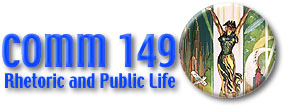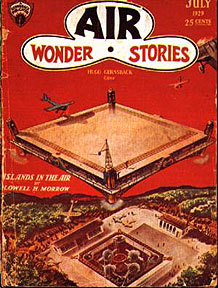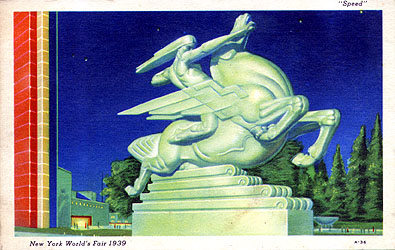
Office: HGH 210; phone: (408) 924-5378
Email: wooda@email.sjsu.edu
Web: http://www.sjsu.edu/faculty/wooda

|
Dr. Andrew Wood Office: HGH 210; phone: (408) 924-5378 Email: wooda@email.sjsu.edu Web: http://www.sjsu.edu/faculty/wooda |
William Gibson's short story illustrates how popular culture and public life are heterogeneous; they are not stable, solid, immutable forces. Rather, our notion of public life includes bits and pieces and fragments of many alternative visions of ideal human interaction. The title refers to Hugo Gernsback, an early twentieth century pulp fiction editor whose bold and vivid stories shaped our collective imagination of the future.

The 'continuum' refers to a conceptual space, an alternative universe that exists along side our own - and occasionally intersects with our 'real' world. This space includes a range of probabilities from the most concrete and sensible to the most abstract and fantastic visions of public life. The Gernsback Continuum is a broad arc of intersecting futures with alternative implications for public life. We can visit this continuum through various means; some are legal and safe, others illegal and dangerous.
The protagonist in Gibson's short story visits the continuum through a mixture of imminent mental breakdown and amphetamine psychosis. The plot begins when the narrator is contracted to photograph examples of art deco architecture along the West Coast. Art Deco refers to a style that featured bold shapes, zigzag and geometric elements, vivid colors, and artificial materials; the movement was popular in the mid-twenties and lasted through the 1930s. One offshoot of deco was a movement called Streamlined Modern that featured sleek, futuristic shapes exuding the power of technology over nature. Here's an example from the 1939 New York World's Fair.

As our narrator follows the 'stations of his convoluted socio-architectural cross', he loses contact with the artifacts of his 'real' world. The public life of his 1980s America, with its crime, nuclear threats and pending environmental collapse, seems to be replaced by fragments of an alternative 1980s-that-wasn't. He catches odd visions and rough hallucinations like a huge flying wing-liner that looks like it might have appeared on one of Gernsback's pulps. Concerned for his sanity, our narrator contacts a friend who makes his living interviewing and writing about individuals and groups who've slipped the permeable membrane of probability - between the reality of our collective public life and the madness that collects where our world intersects with alternative universes. We learn that madness might merely be a symptom that follows our brush with semiotic phantoms. These phantoms are artifacts - buildings, postcards, song lyrics, comic books, speeches, pieces of wall paper - fragments of a collective imagination of public life that has been forgotten, but not fully eliminated.
Our narrator decides that he's had enough of these semiotic phantoms, but not before visiting the Gernsback Continuum one last time. In a dream state, he passes beyond his public life, into the world imagined by streamline modern architects, city planners, and pulp fiction novelists of the 1930s. There, he witnesses an alternative 1980s in which the bold visions of tomorrow - vast, gleaming, spotless cities - came true. In this continuum, the virtues and promise of technology were never perverted by war and disillusionment. The technocracy of plastic, lucite, and stainless steel never mutated into the stark totalitarianism of Hitler's Germany and the subtle tyranny of America's suburbs. Our narrator is drawn to this alternative vision of public life, but he fears it too. He senses that it rests upon a dangerous foundation whose apparent optimism hides a kind of police state. In this world, people seem robotic, hollow, fake. Are all people in this utopia white, wealthy, and happy? What kind of mechanism has so neatly eliminated any trace of difference from this world? Whatever machine or policy that accomplished this shadow-less holocaust must be terrifying, indeed. Our narrator tries to will himself out of this continuum, but finds that his return from the desert to Los Angeles merely showers him with fragments of this half forgotten world. Some cities and places and artifacts, it seems, possess the power to intersect with alternative continuums of public life. At the end of the story, our narrator returns to New York, deciding to drench himself in the troubling artifacts of his real life - violent pornography, newspaper accounts of crime, the detritus of a broken society. He decides that his real world is much better than a perfect society that that can deprive him of his humanity.
The "Gernsback Continuum" illustrates a central question in our course. How might we critique our assumptions about public life without stepping out of our continuum of places and values and texts? Perhaps we must occasionally visit other rhetorical continuums to discern the shape and limitations of our own. As a thought experiment, try this activity: Describe the alternative Tucson of Gibson's "Gernsback Continuum." (1) What are three artifacts of public life in the story? (2) Do any of these artifacts exist in the San Jose/San Francisco Bay area? (3) How are these artifacts integrated into our continuum of public life?
Off-campus webpages
Dannysoar, Norman Bel Geddes - images of the flying wing.
Note: These pages exist outside of San Jose State University servers and their content is not endorsed by the page maintainer or any other university entity. These pages have been selected because they may provide some guidance or insight into the issues discussed in class. Because one can never step into the same electronic river twice, the pages may or may not be available when you request them. If you have any questions or suggestions, please email Dr. Andrew Wood.